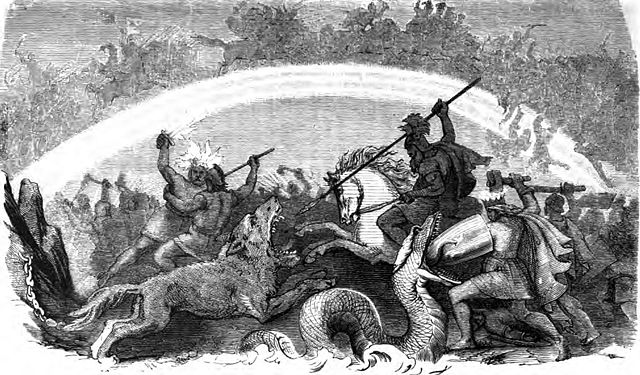You’d think that a news story this big would be impossible to miss, but somehow I overlooked it until just now. I hope you’ll forgive my tardiness, readers, because I have urgent information to impart: the Jorvik Viking Center has predicted that Ragnarok, the Norse apocalypse foretold in the ancient texts called the Eddas, is due to occur on February 22, 2014 – less than two weeks away!
As you doubtless know, Ragnarok is the world-shattering war in which the gods will be slain in battle with monsters of the underworld, the nine realms of the cosmos will be destroyed, and humanity will all be killed off except for a tiny remnant. Just in case you’re not up to speed on the ancient Viking prophecies of Snorri Sturluson, here’s Wikipedia’s description of what’s coming a week from Saturday:
Heimdall raises the Gjallarhorn into the air and blows deeply into it, and Odin converses with Mím’s head. The world tree Yggdrasil shudders and groans. The jötunn Hrym comes from the east, his shield before him. The Midgard serpent Jörmungandr furiously writhes, causing waves to crash. “The eagle shrieks, pale-beaked he tears the corpse,” and the ship Naglfar breaks free thanks to the waves made by Jormungandr and sets sail from the east. The fire jötnar inhabitants of Muspelheim come forth.
The völva continues that Jötunheimr, the land of the jötnar, is aroar, and that the Æsir are in council. The dwarves groan by their stone doors. Surtr advances from the south, his sword brighter than the sun. Rocky cliffs open and the jötnar women sink. People walk the road to Hel and heavens split apart.
The gods then do battle with the invaders: Odin is swallowed whole and alive fighting the wolf Fenrir, causing his wife Frigg her second great sorrow (the first being the death of her son, the god Baldr). The god Freyr fights Surtr and loses. Odin’s son Víðarr avenges his father by rending Fenrir’s jaws apart and stabbing it in the heart with his spear, thus killing the wolf. The serpent Jörmungandr opens its gaping maw, yawning widely in the air, and is met in combat by Thor. Thor, also a son of Odin and described here as protector of the earth, furiously fights the serpent, defeating it, but Thor is only able to take nine steps afterward before collapsing. After this, people flee their homes, and the sun becomes black while the earth sinks into the sea, the stars vanish, steam rises, and flames touch the heavens.
Luckily, it’s not all bad news. After the battle concludes, the earth will rise again from the sea, reborn as a green and fertile land. Two human beings, Líf and Lífþrasir, will also survive by hiding in the wood of Hoddmímis holt, and together they’ll emerge from the devastation and repopulate the world. (The problem of who their first generation of children will be able to marry and mate with, if not their brothers and sisters, is tactfully ignored in Norse mythology just as it is in Christianity.)
The Jorvik Viking Center goes so far as to cite the occurrence of omens foretold in Norse scripture, such as the current harsh winter, the spread of social media, or sea serpents washing up on a Californian beach. That said, since they’re also selling front-row tickets to their Ragnarok festival, I’m pretty sure this is mostly tongue-in-cheek.
But whether it’s the Norse Ragnarok, the 2012 Mayan panic, or any of the other numberless apocalypses that briefly obsessed humanity at one time in history and now lie unfulfilled and forgotten, this is a useful reminder of just how many end-of-the-world predictions that are out there. After all, the Rapture and the second coming of Jesus, or the appearance of the Hidden Imam, are meaningfully different from the Viking prophecies only in terms of how many people still believe in them. This would be a valuable lesson for the devotees of the currently popular doomsday scenarios: to notice how many ancient apocalypses, presumably popular in their own time, have faded to mere mythology and punchline in ours.
Image: “Battle of the Doomed Gods” by Friedrich Wilhelm Heine, via Wikimedia Commons
